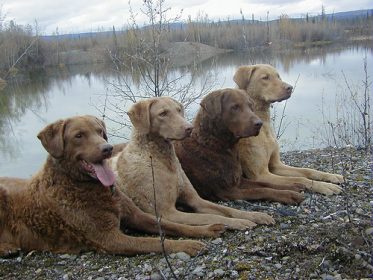
We were tempted to title this post, “Find the Chessie,” with a picture of the dog in a hunting environment because color is an integral part of this breed’s success; the breed standard mandates that “the color of the Chesapeake Bay Retriever must be as nearly that of its working surroundings as possible.” Please understand that there are other qualities of a Chessie more important for the dog to do its job, such as soundness, structure, size, and so on, but all things being equal, if two good quality dogs are standing side by side, one would have to prefer the correctly colored dog over the incorrect one.
There are three basic colors for the Chesapeake: Deadgrass, sedge and brown, and most other colors are simply variations of them. The first dogs registered in the AKC Stud Book were sedge, a light colored dog with shades of red undertones. Some might say sedge is almost a strawberry blonde. Browns were the next color to be registered, and they could be light brown or dark brown with red undertones in the coat (liver used to be described as a color for the Chesapeake, but it has since been disqualified by the AKC). Deadgrass is a color combination from yellow to tan without any reds in any of its shades, and in the early 1900s, it was a trend. That said, we’ve read that today there are more brown Chesapeake than any other color because of the dominant/recessive genes in the colors.
So why is color important? The Chesapeake is a working dog, so think of its coloring as camouflage for the dog. We would guess that most hunters would say drive and ability is more important than color, but we would also guess that given a choice, most would prefer a dog that has it all.
Image of Chesapeake Bay Retrievers found on Pinterest and happily credited upon receipt of information.
